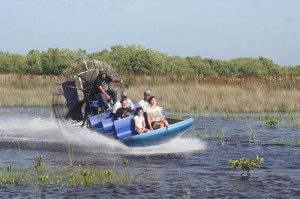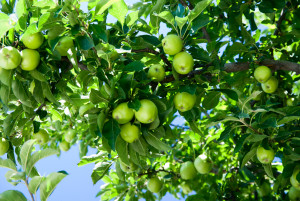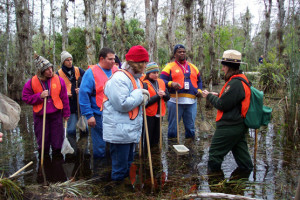 One of the most iconic things in the Everglades National Park is about to start disappearing. No, it’s not an endangered animal or plant, it’s the airboat. For more than 85 years, airboats have been gliding across the waters of the Everglades, but Congress and the National Park Service are looking to phase them out.
One of the most iconic things in the Everglades National Park is about to start disappearing. No, it’s not an endangered animal or plant, it’s the airboat. For more than 85 years, airboats have been gliding across the waters of the Everglades, but Congress and the National Park Service are looking to phase them out.
In 1989, Congress mandated that the U.S. Park Service develop a comprehensive management plan that would include the government buying 9,000 parcels of land. After dozens of meetings and years later, this plan is ready to be implemented, which means an end to private air boating in the park. However, air boaters that can prove they were atleast 16 years old and an active airboater as of 1989 will be grandfathered in. It is still unclear how many will qualify under those parameters. For everyone else, there’s not much time left to keep their business in the Everglades.
The only air boating that will be allowed in the eastern section of the Park will be four commercial air boat tour operations that work as contractors for the park. Park officials will dictate the air boat’s schedules.
Many air boaters, including members of the Airboat Association of Florida, are heartbroken over this news. They believe air boating in the Everglades is a major part of Florida’s culture, and it will now be nearly gone.
Air boaters have the opportunity to air boat elsewhere or on state lands controlled by the Bureau of Land Management. There is also a chance many will disobey the laws and continuing riding through, while being on the lookout for park rangers.
According to the Florida Biodiversity Project, the wetlands are being eroded by air boat traffic. The group wants all air boats banned until its proven the vehicles aren’t violating the Clean Water Act. They believe this ban is the only hope to prevent permanent destruction in the Everglades.
Catch an Airboat Tour While You Can
Airboats will soon be a thing of the past in the Everglades. Catch a ride on one as soon as you can. Airboats allow Park visitors the chance to be up-close-and-personal with the Park. To book an airboat tour, call Captain Mitch’s Airboat Tours at 800-368-0065 or click here.
 The Everglades is home to an array of plants that thrive in the wet, subtropical climate. Although mangroves and grasses come to many people’s minds when thinking about plant life in the Everglades, we’d like to profile a plant that many people might not know about that is native to the area: the pond apple.
The Everglades is home to an array of plants that thrive in the wet, subtropical climate. Although mangroves and grasses come to many people’s minds when thinking about plant life in the Everglades, we’d like to profile a plant that many people might not know about that is native to the area: the pond apple. Thinking about heading to the Everglades? Or want to experience it in a different way? Try slough slogging. Ever heard of it? Slough slogging is a great way to experience the Everglades – participants get up close and personal with the environment. In short, slough slogging is a wet hike, or off-trail hiking, in the wetlands in the park with a park ranger.
Thinking about heading to the Everglades? Or want to experience it in a different way? Try slough slogging. Ever heard of it? Slough slogging is a great way to experience the Everglades – participants get up close and personal with the environment. In short, slough slogging is a wet hike, or off-trail hiking, in the wetlands in the park with a park ranger. The Everglades is a beautiful, majestic place perfect for you to explore and enjoy in a variety of different ways. If you’re looking for some extra exercise and a peaceful and enjoyable way to experience the park, you should try biking through Shark Valley.
The Everglades is a beautiful, majestic place perfect for you to explore and enjoy in a variety of different ways. If you’re looking for some extra exercise and a peaceful and enjoyable way to experience the park, you should try biking through Shark Valley.





